Functional Alignment Philosophy in Total Knee Arthroplasty—Rationale and Technique for the Valgus Morphotype Using an Image Based Robotic Platform and Individualized Planning
Abstract
1. Introduction
2. Functional Alignment Principles
2.1. Individualized Pre-Operative Planning
2.1.1. Femur
- Size: posterior referencing with the smallest size that does not overhang mediolaterally, does not notch the anterior femur and avoids overstuffing the patellofemoral joint.
- Coronal plane: femoral implant positioning is planned according to the LDFA with an upper limit of 6° mechanical valgus in femur. To achieve a final alignment with a maximum valgus of 183°, varus positioning on the tibia may be required unless there is extra-articular varus deformity in either the femur or tibia.
- Sagittal plane: femoral component is positioned to achieve the best match possible to the concentricity of Blumensaats line in cases without trochlea dysplasia and to avoid femoral notching. This minimizes patellofemoral over or under stuffing.
- Axial plane: In the valgus morphotype, the posterior lateral femoral condyle is often deficient, making the posterior condylar axis an unreliable landmark for rotation [38]. For this reason, femoral component rotation is planned to balance the flexion space according to the transepicondylar axis (TEA), within a range of 3° internal rotation (IR) to 6° external rotation (ER) to balance the flexion gap. All these adjustments must be made while respecting the alignment with the trochlear groove; care must be taken to assess for trochlea dysplasia which may be present in valgus knees, and if so, recreation of the dysplastic anatomy, such as internally rotating the femur relative to the posterior condylar axis (PCA), should be avoided.
- Resection depth: For distal femoral resection, the medial femoral condyle represents the reference point. A smaller amount of bone is typically removed from the lateral femoral condyle because of wear and morphological variation that is encountered here. It is 9 mm resection if planned from the medial distal femoral condyle and typically 4-6mm from the lateral femoral condyle. The target of 9 mm resection is based on 7 mm of bone plus 2 mm of cartilage.
- Medio-lateral positioning: the lateral patella soft tissue structures are typically tight in a valgus knee, and any medialization of the trochlea groove may exacerbate this and potentially cause patellofemoral dysfunction. However, when using a PS femoral component, care must be exercised that lateralization will not lead to a box cut, which will create a fracture of the lateral femoral condyle due to a thin bony remnant in the lateral column.
2.1.2. Tibia
- Size: The tibia is initially sized with rotation to 0° on the axial view of the CT scan with the aim of having maximal cortical contact with no implant overhang.
- Coronal plane: tibial implant position is aligned to provide the closest match to the medial proximal tibial axis (MPTA) and balance flexion and extension gaps in a range from 2° of valgus to 6° of varus. In the valgus morphotype, in order to avoid a residual valgus HKA > 3° valgus, the tibia is often cut orthogonal to its mechanical axis. A valgus tibial position more than 2° should be avoided. Valgus tibial positioning is reserved for cases where the deformity is an extra-articular tibial deformity, which in our experience is uncommon.
- Sagittal plane: tibial implant position is set to match the patient’s native posterior tibial slope with a limit of 3° when using a PS implant and can be modified to balance the flexion gap if necessary. A limit of 10° combined femoral-tibial flexion is allowed.
- Axial plane: tibial implant is positioned using Akagi’s line. Particular attention should be paid to the avoiding IR of the tibial component, as the valgus morphotype tibia typically falls into ER in deep flexion [36,37] (the position the implant is placed), which promotes the error of internally rotating the tibial baseplate during trials and implantation.
- Tibial resection: 8 mm resection is planned from the medial tibial plateau (6 mm bone + 2 mm cartilage) based on subchondral bone and an average cartilage depth of 2 mm in the normal knee, to use a 9 mm polyethylene insert. Resection from lateral tibial plateau is, typically less i.e., 4–6mm due to wear, but also to account for the extra articular tibial valgus deformity that often co-exists in the valgus morphotype [31]. This gives a combined planned resection of 17 mm medially, which is the combined thickness of this implant with its thinnest tibial liner.
2.2. Coronal Alignment to Aim for Constitutional Alignment within 3° of Neutral
2.3. Equal Laxity of Femoro-Tibial Compartments in Flexion and Extension
2.4. Final Limb Sagittal Alignment to Achieve Full Extension
3. Discussion
3.1. Morphotypes
3.2. Soft Tissue Balancing
3.3. Coronal Alignment
3.4. Femoral Rotation
3.5. Future Study and Weakness’s
4. Conclusions
Author Contributions
Funding
Institutional Review Board Statement
Informed Consent Statement
Data Availability Statement
Acknowledgments
Conflicts of Interest
References
- Insall, J.N.; Binazzi, R.; Soudry, M.; Mestriner, L.A. Total knee arthroplasty. Clin. Orthop. Relat. Res. 1985, 192, 13–22. [Google Scholar] [CrossRef]
- Nam, D.; Nunley, R.M.; Barrack, R.L. Patient dissatisfaction following total knee replacement: A growing concern? Bone Jt. J. 2014, 96-B, 96–100. [Google Scholar] [CrossRef] [PubMed]
- Bourne, R.B.; Chesworth, B.M.; Davis, A.M.; Mahomed, N.N.; Charron, K.D. Patient satisfaction after total knee arthroplasty: Who is satisfied and who is not? Clin. Orthop. Relat. Res. 2010, 468, 57–63. [Google Scholar] [CrossRef] [PubMed]
- Bellemans, J.; Colyn, W.; Vandenneucker, H.; Victor, J. The Chitranjan Ranawat award: Is neutral mechanical alignment normal for all patients? The concept of constitutional varus. Clin. Orthop. Relat. Res. 2012, 470, 45–53. [Google Scholar] [CrossRef]
- Hirschmann, M.T.; Hess, S.; Behrend, H.; Amsler, F.; Leclercq, V.; Moser, L.B. Phenotyping of hip-knee-ankle angle in young non-osteoarthritic knees provides better understanding of native alignment variability. Knee Surg. Sport. Traumatol. Arthrosc. 2019, 27, 1378–1384. [Google Scholar] [CrossRef]
- Winnock de Grave, P.; Luyckx, T.; Claeys, K.; Tampere, T.; Kellens, J.; Müller, J.; Gunst, P. Higher satisfaction after total knee arthroplasty using restricted inverse kinematic alignment compared to adjusted mechanical alignment. Knee Surg. Sport. Traumatol. Arthrosc. 2022, 30, 488–499. [Google Scholar] [CrossRef] [PubMed]
- Howell, S.M.; Kuznik, K.; Hull, M.L.; Siston, R.A. Results of an initial experience with custom-fit positioning total knee arthroplasty in a series of 48 patients. Orthopedics 2008, 31, 857–863. [Google Scholar] [CrossRef] [PubMed]
- Almaawi, A.M.; Hutt, J.R.B.; Masse, V.; Lavigne, M.; Vendittoli, P.A. The Impact of Mechanical and Restricted Kinematic Alignment on Knee Anatomy in Total Knee Arthroplasty. J. Arthroplast. 2017, 32, 2133–2140. [Google Scholar] [CrossRef] [PubMed]
- Hungerford, D.S.; Krackow, K.A. Total joint arthroplasty of the knee. Clin. Orthop. Relat. Res. 1985, 192, 23–33. [Google Scholar] [CrossRef]
- Hollister, A.M.; Jatana, S.; Singh, A.K.; Sullivan, W.W.; Lupichuk, A.G. The axes of rotation of the knee. Clin. Orthop. Relat. Res. 1993, 290, 259–268. [Google Scholar] [CrossRef]
- Sultan, A.A.; Samuel, L.T.; Khlopas, A.; Sodhi, N.; Bhowmik-Stoker, M.; Chen, A.; Orozco, F.; Kolisek, F.; Mahoney, O.; Smith, L.; et al. Robotic-Arm Assisted Total Knee Arthroplasty More Accurately Restored the Posterior Condylar Offset Ratio and the Insall-Salvati Index Compared to the Manual Technique; A Cohort-Matched Study. Surg. Technol. Int. 2019, 34, 409–413. [Google Scholar] [PubMed]
- Kayani, B.; Konan, S.; Huq, S.S.; Tahmassebi, J.; Haddad, F.S. Robotic-arm assisted total knee arthroplasty has a learning curve of seven cases for integration into the surgical workflow but no learning curve effect for accuracy of implant positioning. Knee Surg. Sport. Traumatol. Arthrosc. 2019, 27, 1132–1141. [Google Scholar] [CrossRef] [PubMed]
- Hampp, E.L.; Chughtai, M.; Scholl, L.Y.; Sodhi, N.; Bhowmik-Stoker, M.; Jacofsky, D.J.; Mont, M.A. Robotic-Arm Assisted Total Knee Arthroplasty Demonstrated Greater Accuracy and Precision to Plan Compared with Manual Techniques. J. Knee Surg. 2019, 32, 239–250. [Google Scholar] [CrossRef]
- Sires, J.D.; Wilson, C.J. CT Validation of Intraoperative Implant Position and Knee Alignment as Determined by the MAKO Total Knee Arthroplasty System. J. Knee Surg. 2021, 34, 1133–1137. [Google Scholar] [CrossRef] [PubMed]
- Hilding, M.B.; Lanshammar, H.; Ryd, L. Knee joint loading and tibial component loosening. RSA and gait analysis in 45 osteoarthritic patients before and after TKA. J. Bone Jt. Surg. Br. 1996, 78, 66–73. [Google Scholar] [CrossRef]
- Sharkey, P.F.; Hozack, W.J.; Rothman, R.H.; Shastri, S.; Jacoby, S.M. Insall Award paper. Why are total knee arthroplasties failing today? Clin. Orthop. Relat. Res. 2002, 404, 7–13. [Google Scholar] [CrossRef]
- Wakelin, E.A.; Shalhoub, S.; Lawrence, J.M.; Keggi, J.M.; DeClaire, J.H.; Randall, A.L.; Ponder, C.E.; Koenig, J.A.; Lyman, S.; Plaskos, C. Improved total knee arthroplasty pain outcome when joint gap targets are achieved throughout flexion. Knee Surg. Sport. Traumatol. Arthrosc. 2022, 30, 939–947. [Google Scholar] [CrossRef]
- Sappey-Marinier, E.; Batailler, C.; Swan, J.; Schmidt, A.; Cheze, L.; MacDessi, S.J.; Servien, E.; Lustig, S. Mechanical alignment for primary TKA may change both knee phenotype and joint line obliquity without influencing clinical outcomes: A study comparing restored and unrestored joint line obliquity. Knee Surg. Sport. Traumatol. Arthrosc. 2022, 30, 2806–2814. [Google Scholar] [CrossRef] [PubMed]
- Lustig, S.; Sappey-Marinier, E.; Fary, C.; Servien, E.; Parratte, S.; Batailler, C. Personalized alignment in total knee arthroplasty: Current concepts. SICOT J. 2021, 7, 19. [Google Scholar] [CrossRef] [PubMed]
- Karachalios, T.; Komnos, G.A. Individualized surgery in primary total knee arthroplasty. EFORT Open Rev. 2020, 5, 663–671. [Google Scholar] [CrossRef]
- Oussedik, S.; Abdel, M.P.; Victor, J.; Pagnano, M.W.; Haddad, F.S. Alignment in total knee arthroplasty. Bone Jt. J. 2020, 102-B, 276–279. [Google Scholar] [CrossRef] [PubMed]
- Shatrov, J.; Batailler, C.; Sappey-Marinier, E.; Gunst, S.; Servien, E.; Lustig, S. Correction Notice to: Functional Alignment Philosophy in Total Knee Arthroplasty-Rationale and technique for the varus morphotype using a CT based robotic platform and individualized planning. SICOT J. 2022, 8, 18. [Google Scholar] [CrossRef] [PubMed]
- Shatrov, J.; Batailler, C.; Sappey-Marinier, E.; Gunst, S.; Servien, E.; Lustig, S. Kinematic alignment fails to achieve balancing in 50% of varus knees and resects more bone compared to functional alignment. Knee Surg. Sport. Traumatol. Arthrosc. 2022, 30, 2991–2999. [Google Scholar] [CrossRef] [PubMed]
- Shatrov, J.; Coulin, B.; Batailler, C.; Servien, E.; Walter, B.; Lustig, S. Alignment philosophy influences trochlea recreation in total knee arthroplasty: A comparative study using image-based robotic technology. Int. Orthop. 2022, 1–13. [Google Scholar] [CrossRef] [PubMed]
- Hirschmann, M.T.; Behrend, H. Functional knee phenotypes: A call for a more personalised and individualised approach to total knee arthroplasty? Knee Surg. Sport. Traumatol. Arthrosc. 2018, 26, 2873–2874. [Google Scholar] [CrossRef]
- Mullaji, A.; Bhoskar, R.; Singh, A.; Haidermota, M. Valgus arthritic knees can be classified into nine phenotypes. Knee Surg. Sport. Traumatol. Arthrosc. 2022, 30, 2895–2904. [Google Scholar] [CrossRef]
- Ranawat, A.S.; Ranawat, C.S.; Elkus, M.; Rasquinha, V.J.; Rossi, R.; Babhulkar, S. Total knee arthroplasty for severe valgus deformity. J. Bone Jt. Surg. Am. 2005, 87 Pt 2, 271–284. [Google Scholar] [CrossRef]
- Insall, J.; Scott, W.N.; Ranawat, C.S. The total condylar knee prosthesis. A report of two hundred and twenty cases. J. Bone Jt. Surg. Am. 1979, 61, 173–180. [Google Scholar] [CrossRef]
- Whiteside, L.A. Selective ligament release in total knee arthroplasty of the knee in valgus. Clin. Orthop. Relat. Res. 1999, 367, 130–140. [Google Scholar] [CrossRef]
- Krackow, K.A.; Jones, M.M.; Teeny, S.M.; Hungerford, D.S. Primary total knee arthroplasty in patients with fixed valgus deformity. Clin. Orthop. Relat. Res. 1991, 273, 9–18. [Google Scholar] [CrossRef]
- Thienpont, E.; Schwab, P.E.; Cornu, O.; Bellemans, J.; Victor, J. Bone morphotypes of the varus and valgus knee. Arch. Orthop. Trauma Surg. 2017, 137, 393–400. [Google Scholar] [CrossRef] [PubMed]
- Eberbach, H.; Mehl, J.; Feucht, M.J.; Bode, G.; Sudkamp, N.P.; Niemeyer, P. Geometry of the Valgus Knee: Contradicting the Dogma of a Femoral-Based Deformity. Am. J. Sport Med. 2017, 45, 909–914. [Google Scholar] [CrossRef] [PubMed]
- Lombardi, A.V., Jr.; Dodds, K.L.; Berend, K.R.; Mallory, T.H.; Adams, J.B. An algorithmic approach to total knee arthroplasty in the valgus knee. J. Bone Jt. Surg. Am. 2004, 86-A (Suppl. 2), 62–71. [Google Scholar] [CrossRef]
- Rossi, R.; Rosso, F.; Cottino, U.; Dettoni, F.; Bonasia, D.E.; Bruzzone, M. Total knee arthroplasty in the valgus knee. Int. Orthop. 2014, 38, 273–283. [Google Scholar] [CrossRef] [PubMed]
- MacDessi, S.J.; Griffiths-Jones, W.; Harris, I.A.; Bellemans, J.; Chen, D.B. Coronal Plane Alignment of the Knee (CPAK) classification. Bone Jt. J. 2021, 103-B, 329–337. [Google Scholar] [CrossRef]
- Baier, C.; Benditz, A.; Koeck, F.; Keshmiri, A.; Grifka, J.; Maderbacher, G. Different Kinematics of Knees with Varus and Valgus Deformities. J. Knee Surg. 2018, 31, 264–269. [Google Scholar] [CrossRef]
- Kawaguchi, K.; Inui, H.; Taketomi, S.; Yamagami, R.; Takagi, K.; Kage, T.; Sameshima, S.; Tanaka, S. Rotational kinematics differ between mild and severe valgus knees in total knee arthroplasty. Knee 2021, 28, 81–88. [Google Scholar] [CrossRef]
- Lange, J.; Haas, S.B. Correcting severe valgus deformity: Taking out the knock. Bone Jt. J. 2017, 99-B, 60–64. [Google Scholar] [CrossRef]
- Moser, L.B.; Hess, S.; Amsler, F.; Behrend, H.; Hirschmann, M.T. Native non-osteoarthritic knees have a highly variable coronal alignment: A systematic review. Knee Surg. Sport. Traumatol. Arthrosc. 2019, 27, 1359–1367. [Google Scholar] [CrossRef] [PubMed]
- Nishitani, K.; Kuriyama, S.; Nakamura, S.; Morita, Y.; Ito, H.; Matsuda, S. Valgus position of the femoral component causes abnormal kinematics in the presence of medial looseness in total knee arthroplasty: A computer simulation model of TKA for valgus knee osteoarthritis. Knee Surg. Sport. Traumatol. Arthrosc. 2019, 27, 2051–2060. [Google Scholar] [CrossRef]
- Lee, S.S.; Lee, H.; Lee, D.H.; Moon, Y.W. Slight under-correction following total knee arthroplasty for a valgus knee results in similar clinical outcomes. Arch. Orthop. Trauma Surg. 2018, 138, 1011–1019. [Google Scholar] [CrossRef]
- Kittl, C.; Robinson, J.; Raschke, M.J.; Olbrich, A.; Frank, A.; Glasbrenner, J.; Herbst, E.; Domnick, C.; Herbort, M. Medial collateral ligament reconstruction graft isometry is effected by femoral position more than tibial position. Knee Surg. Sport. Traumatol. Arthrosc. 2021, 29, 3800–3808. [Google Scholar] [CrossRef]
- Goudie, S.T.; Deakin, A.H.; Ahmad, A.; Maheshwari, R.; Picard, F. Flexion contracture following primary total knee arthroplasty: Risk factors and outcomes. Orthopedics 2011, 34, e855–e859. [Google Scholar] [CrossRef] [PubMed]
- Cheng, K.; Ridley, D.; Bird, J.; McLeod, G. Patients with fixed flexion deformity after total knee arthroplasty do just as well as those without: Ten-year prospective data. Int. Orthop. 2010, 34, 663–667. [Google Scholar] [CrossRef] [PubMed]
- Mesnard, G.; Batailler, C.; Fary, C.; Schmidt, A.; Servien, E.; Lustig, S. Posterior-Stabilized TKA in Patients With Severe Genu Recurvatum Achieves Good Clinical and Radiological Results at 5-year Minimum Follow-Up: A Case-Controlled Study. J. Arthroplast. 2021, 36, 3154–3160. [Google Scholar] [CrossRef] [PubMed]
- Sharkey, P.F.; Lichstein, P.M.; Shen, C.; Tokarski, A.T.; Parvizi, J. Why are total knee arthroplasties failing today--Has anything changed after 10 years? J. Arthroplast. 2014, 29, 1774–1778. [Google Scholar] [CrossRef]
- Wilson, C.J.; Theodoulou, A.; Damarell, R.A.; Krishnan, J. Knee instability as the primary cause of failure following Total Knee Arthroplasty (TKA): A systematic review on the patient, surgical and implant characteristics of revised TKA patients. Knee 2017, 24, 1271–1281. [Google Scholar] [CrossRef]
- Keggi, J.M.; Wakelin, E.A.; Koenig, J.A.; Lawrence, J.M.; Randall, A.L.; Ponder, C.E.; DeClaire, J.H.; Shalhoub, S.; Lyman, S.; Plaskos, C. Impact of intra-operative predictive ligament balance on post-operative balance and patient outcome in TKA: A prospective multicenter study. Arch. Orthop. Trauma Surg. 2021, 141, 2165–2174. [Google Scholar] [CrossRef]
- Azukizawa, M.; Kuriyama, S.; Nakamura, S.; Nishitani, K.; Lyman, S.; Morita, Y.; Furu, M.; Ito, H.; Matsuda, S. Intraoperative medial joint laxity in flexion decreases patient satisfaction after total knee arthroplasty. Arch. Orthop. Trauma Surg. 2018, 138, 1143–1150. [Google Scholar] [CrossRef]
- Golladay, G.J.; Bradbury, T.L.; Gordon, A.C.; Fernandez-Madrid, I.J.; Krebs, V.E.; Patel, P.D.; Suarez, J.C.; Rueda, C.A.H.; Barsoum, W.K. Are Patients More Satisfied With a Balanced Total Knee Arthroplasty? J. Arthroplast. 2019, 34, S195–S200. [Google Scholar] [CrossRef] [PubMed]
- Deep, K. Collateral ligament laxity in knees: What is normal? Clin. Orthop. Relat. Res. 2014, 472, 3426–3431. [Google Scholar] [CrossRef] [PubMed]
- Shultz, S.J.; Sander, T.C.; Kirk, S.E.; Perrin, D.H. Sex differences in knee joint laxity change across the female menstrual cycle. J. Sport. Med. Phys. Fit. 2005, 45, 594–603. [Google Scholar]
- Aunan, E.; Kibsgard, T.J.; Diep, L.M.; Rohrl, S.M. Intraoperative ligament laxity influences functional outcome 1 year after total knee arthroplasty. Knee Surg. Sport. Traumatol. Arthrosc. 2015, 23, 1684–1692. [Google Scholar] [CrossRef] [PubMed]
- Kayani, B.; Konan, S.; Horriat, S.; Ibrahim, M.S.; Haddad, F.S. Posterior cruciate ligament resection in total knee arthroplasty: The effect on flexion-extension gaps, mediolateral laxity, and fixed flexion deformity. Bone Jt. J. 2019, 101-B, 1230–1237. [Google Scholar] [CrossRef] [PubMed]
- Graichen, H.; Lekkreusuwan, K.; Eller, K.; Grau, T.; Hirschmann, M.T.; Scior, W. A single type of varus knee does not exist: Morphotyping and gap analysis in varus OA. Knee Surg. Sport. Traumatol. Arthrosc. 2022, 30, 2600–2608. [Google Scholar] [CrossRef]
- Matziolis, G.; Matziolis, D.; Perka, C. Pre-operative frontal plane malalignment predicts the extension gap asymmetry in knee osteoarthritis. Int. Orthop. 2012, 36, 79–82. [Google Scholar] [CrossRef]
- Matsumoto, T.; Muratsu, H.; Kubo, S.; Matsushita, T.; Kurosaka, M.; Kuroda, R. The influence of preoperative deformity on intraoperative soft tissue balance in posterior-stabilized total knee arthroplasty. J. Arthroplast. 2011, 26, 1291–1298. [Google Scholar] [CrossRef]
- Okamoto, S.; Okazaki, K.; Mitsuyasu, H.; Matsuda, S.; Iwamoto, Y. Lateral soft tissue laxity increases but medial laxity does not contract with varus deformity in total knee arthroplasty. Clin. Orthop. Relat. Res. 2013, 471, 1334–1342. [Google Scholar] [CrossRef]
- Roth, J.D.; Howell, S.M.; Hull, M.L. Native Knee Laxities at 0 degrees, 45 degrees, and 90 degrees of Flexion and Their Relationship to the Goal of the Gap-Balancing Alignment Method of Total Knee Arthroplasty. J. Bone Jt. Surg. Am. 2015, 97, 1678–1684. [Google Scholar] [CrossRef]
- Tokuhara, Y.; Kadoya, Y.; Nakagawa, S.; Kobayashi, A.; Takaoka, K. The flexion gap in normal knees: An MRI study. J. Bone Jt. Surg. Br. 2004, 86, 1133–1136. [Google Scholar] [CrossRef]
- Magnussen, R.A.; Weppe, F.; Demey, G.; Servien, E.; Lustig, S. Residual varus alignment does not compromise results of TKAs in patients with preoperative varus. Clin. Orthop. Relat. Res. 2011, 469, 3443–3450. [Google Scholar] [CrossRef] [PubMed]
- Wan, X.F.; Yang, Y.; Wang, D.; Xu, H.; Huang, C.; Zhou, Z.K.; Xu, J. Comparison of Outcomes After Total Knee Arthroplasty Involving Postoperative Neutral or Residual Mild Varus Alignment: A Systematic Review and Meta-analysis. Orthop. Surg. 2022, 14, 177–189. [Google Scholar] [CrossRef] [PubMed]
- Howell, S.M.; Gill, M.; Shelton, T.J.; Nedopil, A.J. Reoperations are few and confined to the most valgus phenotypes 4 years after unrestricted calipered kinematically aligned TKA. Knee Surg. Sport. Traumatol. Arthrosc. 2022, 30, 948–957. [Google Scholar] [CrossRef] [PubMed]
- Nedopil, A.J.; Howell, S.M.; Hull, M.L. What clinical characteristics and radiographic parameters are associated with patellofemoral instability after kinematically aligned total knee arthroplasty? Int. Orthop. 2017, 41, 283–291. [Google Scholar] [CrossRef]
- Nedopil, A.J.; Howell, S.M.; Hull, M.L. Does Malrotation of the Tibial and Femoral Components Compromise Function in Kinematically Aligned Total Knee Arthroplasty? Orthop. Clin. N. Am. 2016, 47, 41–50. [Google Scholar] [CrossRef]
- Chalmers, B.P.; LaGreca, M.; Addona, J.; Sculco, P.K.; Haas, S.B.; Mayman, D.J. Characterizing the Magnitude of and Risk Factors for Functional Limb Lengthening in Patients Undergoing Primary Total Knee Arthroplasty. HSS J. 2022, 18, 271–276. [Google Scholar] [CrossRef]
- Talbot, S.; Dimitriou, P.; Mullen, M.; Bartlett, J. Referencing the sulcus line of the trochlear groove and removing intraoperative parallax errors improve femoral component rotation in total knee arthroplasty. Knee Surg. Sport. Traumatol. Arthrosc. 2017, 25, 2743–2750. [Google Scholar] [CrossRef]
- Victor, J. Rotational alignment of the distal femur: A literature review. Orthop. Traumatol. Surg. Res. 2009, 95, 365–372. [Google Scholar] [CrossRef]
- Berger, R.A.; Rubash, H.E.; Seel, M.J.; Thompson, W.H.; Crossett, L.S. Determining the rotational alignment of the femoral component in total knee arthroplasty using the epicondylar axis. Clin. Orthop. Relat. Res. 1993, 286, 40–47. [Google Scholar] [CrossRef]
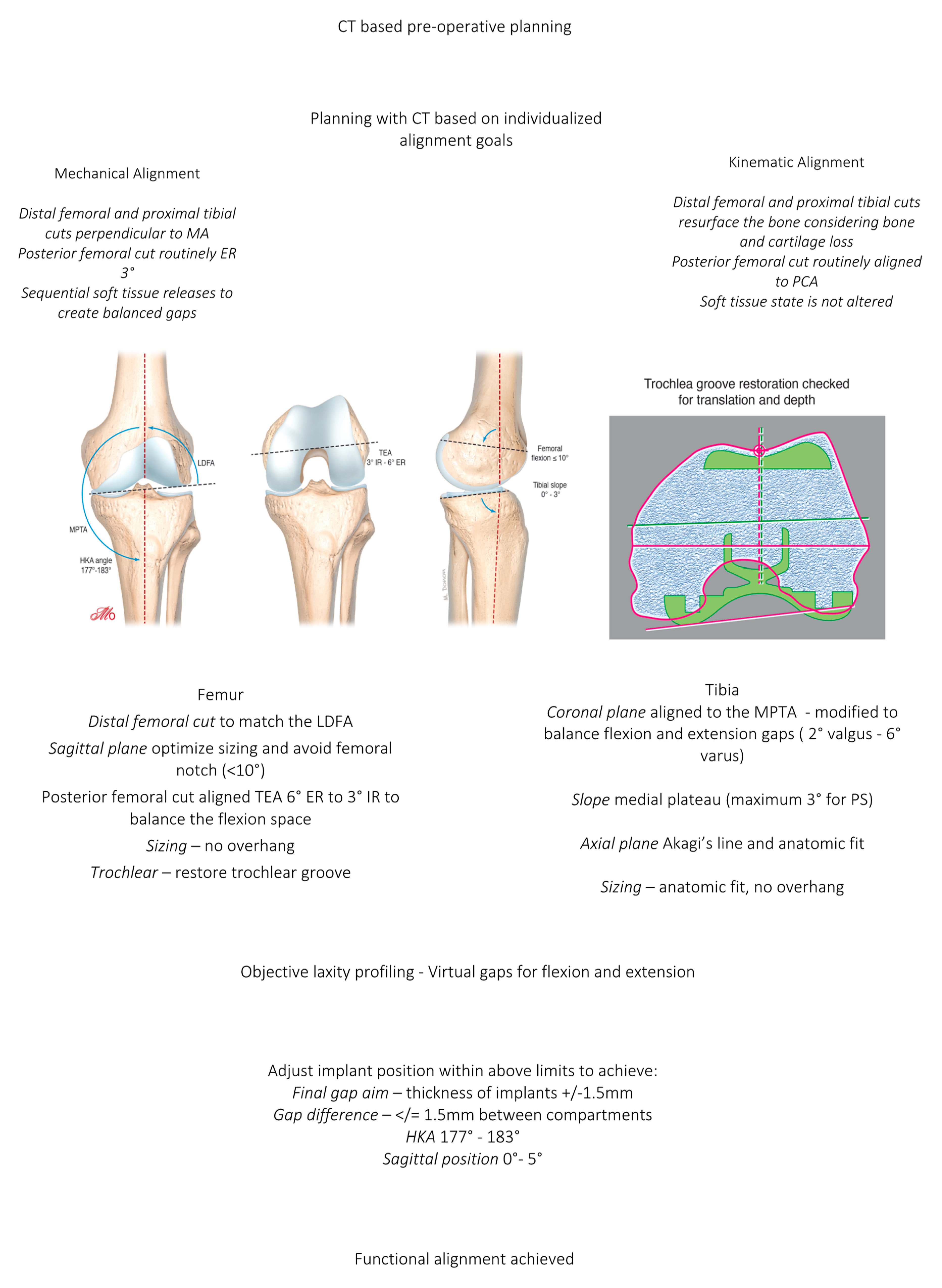
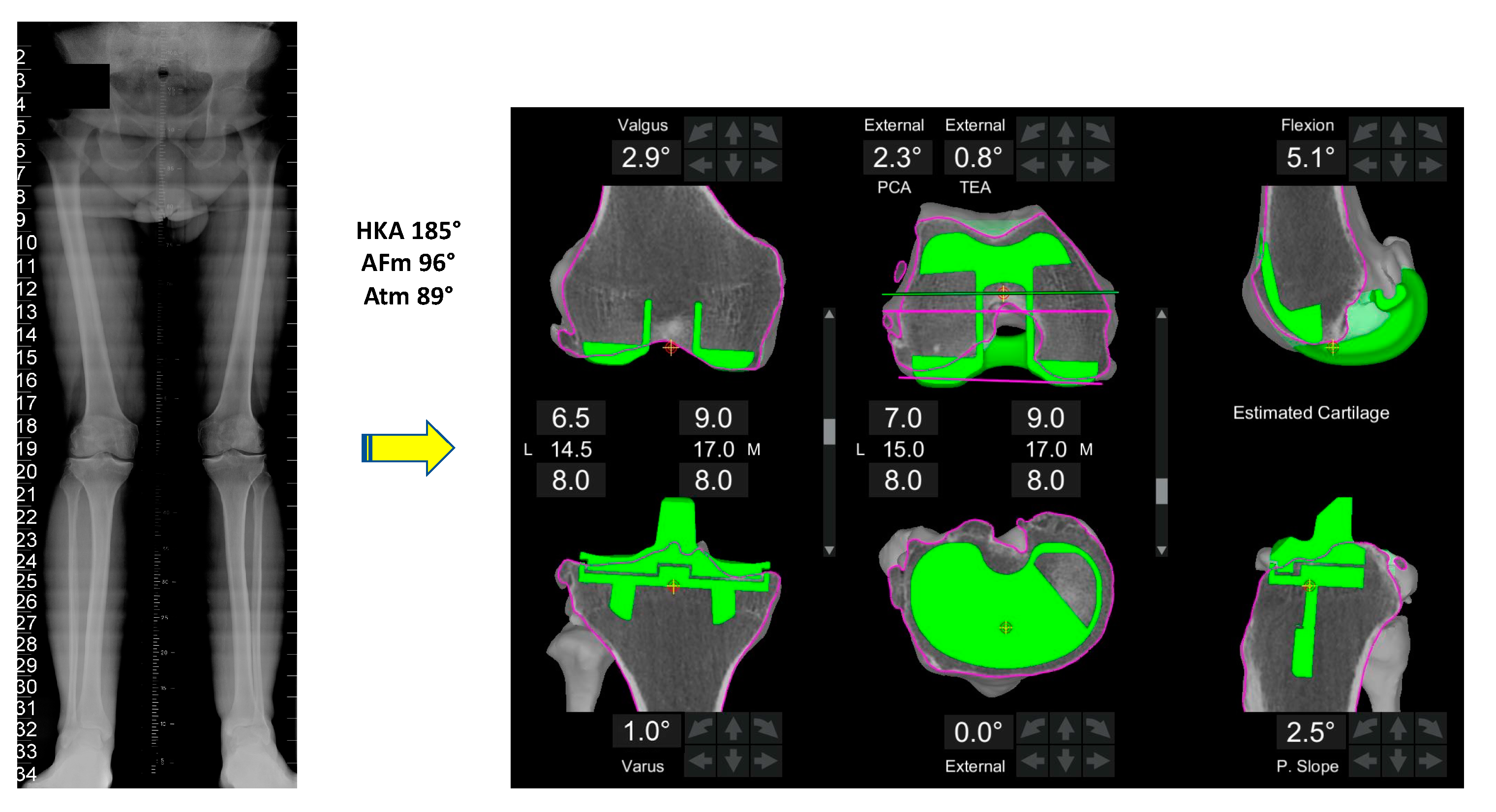
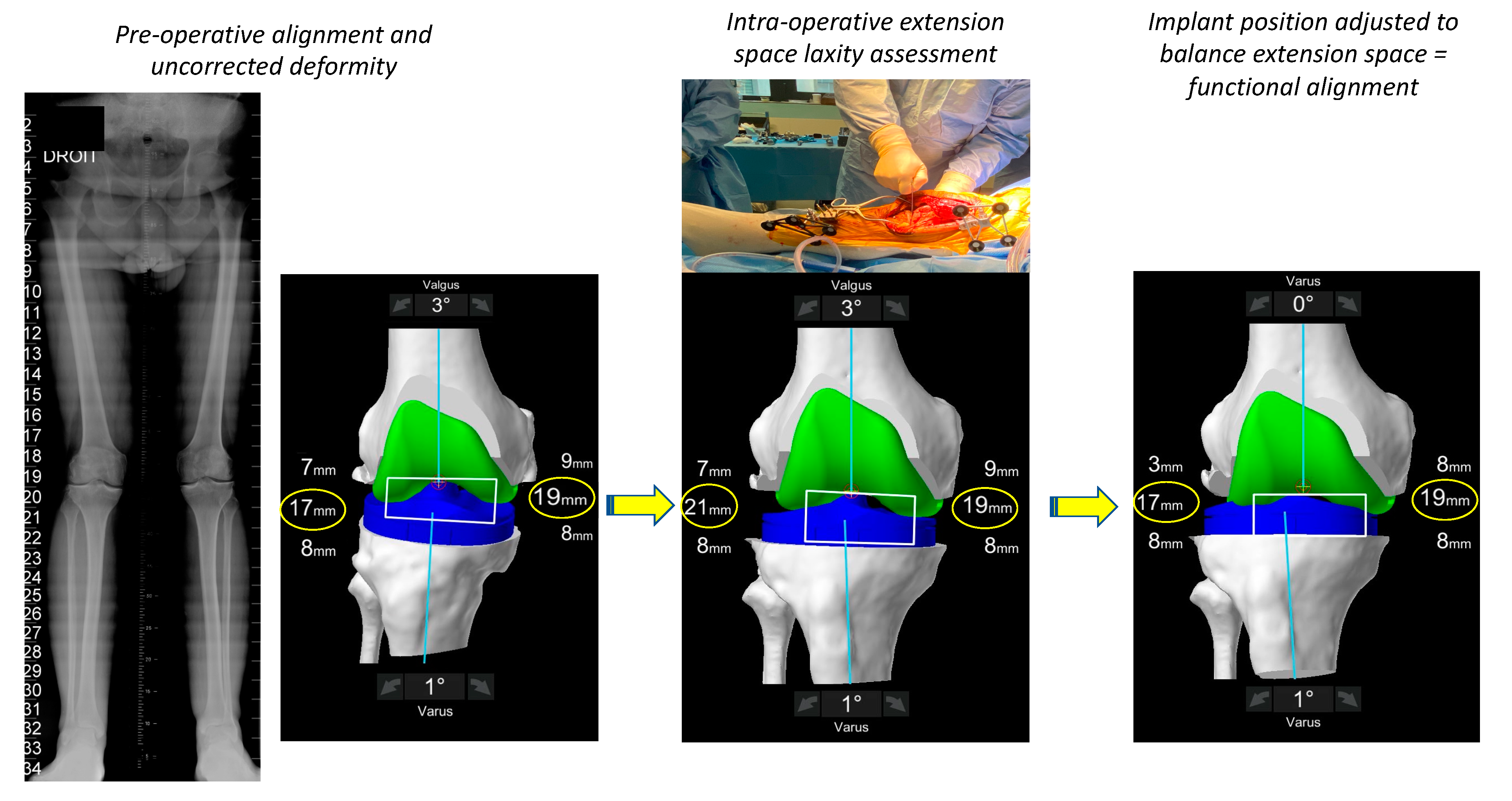
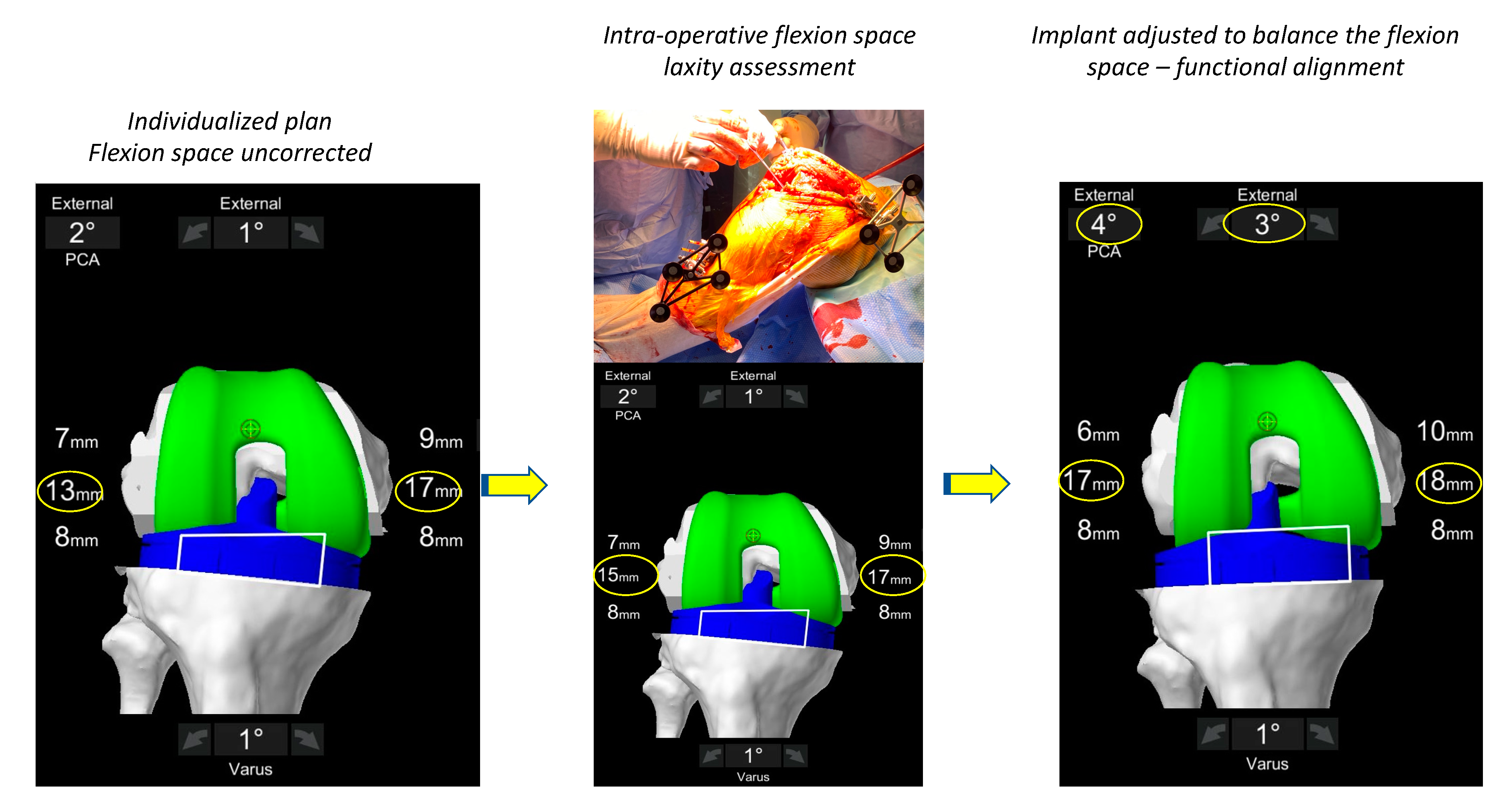
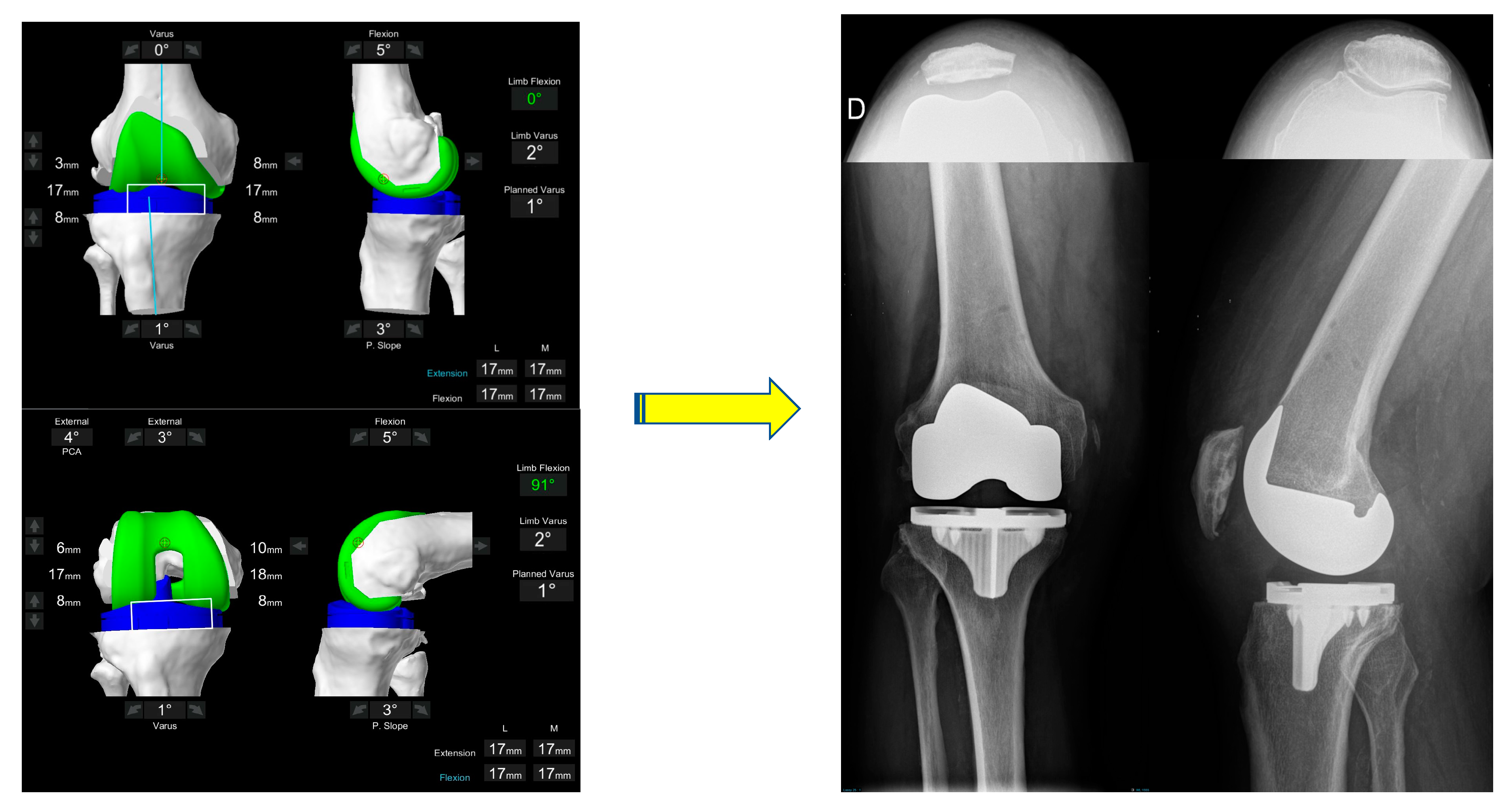
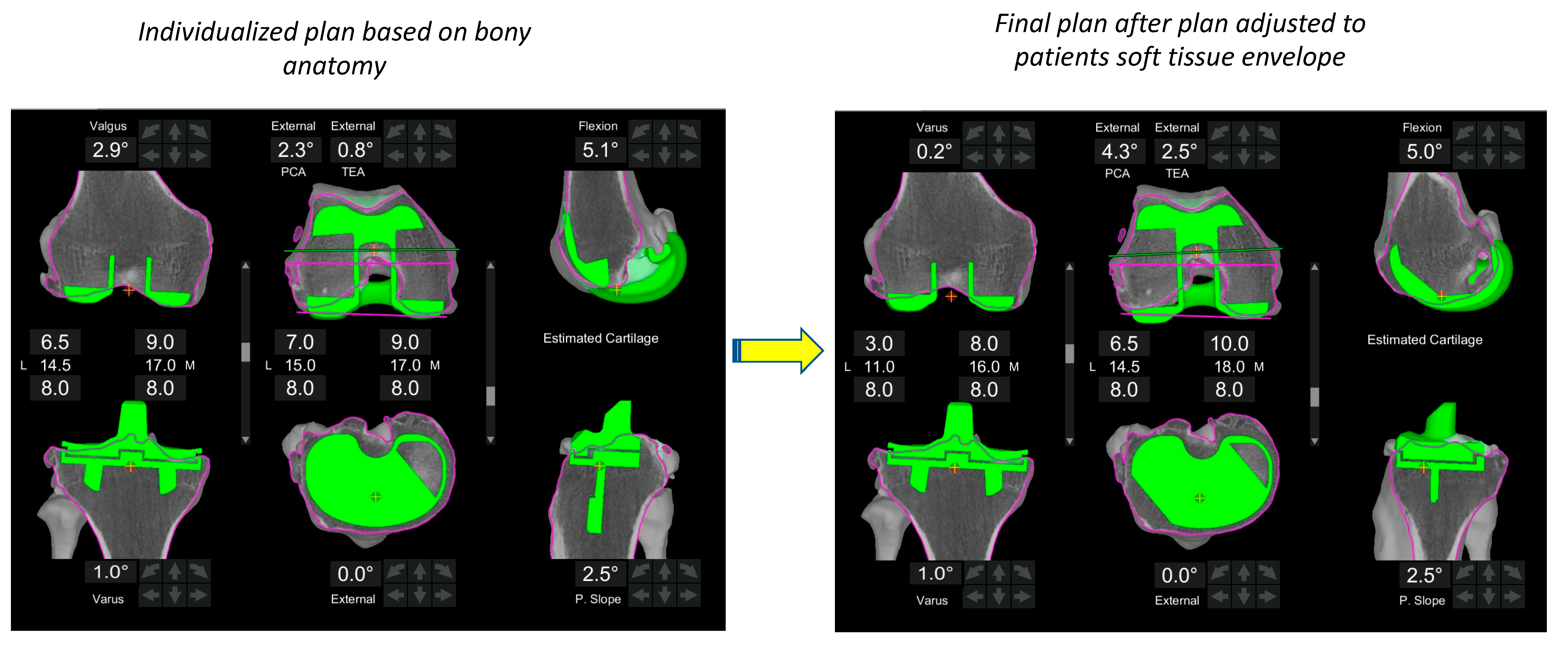
| Parameter | Target |
|---|---|
| Final coronal alignment (HKA) | 177°–183° |
| Final sagittal alignment with gravity only | 0° +/− 5° |
| Femur | |
| Varus/valgus * | 3° varus to 6° valgus |
| Flexion * | 0°–10° |
| Transepicondylar axis (TEA) | 3° IR–6° ER |
| Tibia Varus/valgus * Slope * Rotation | 2° valgus to 6° varus 0°–3° (depends if CR/CS or PS) Manual Combination of Akagi’s line, anatomic fit and floating method |
| Implant sizing | Femur—matched to curvature of distal femoral radius to avoid notching and medial-lateral condyles to avoid any overhang or over-stuffing Tibia—maximal cortical contact with correct rotation with no overhang Downsized if there is any conflict |
| Balancing | Gaps to match the global thickness of the implant at:
|
Disclaimer/Publisher’s Note: The statements, opinions and data contained in all publications are solely those of the individual author(s) and contributor(s) and not of MDPI and/or the editor(s). MDPI and/or the editor(s) disclaim responsibility for any injury to people or property resulting from any ideas, methods, instructions or products referred to in the content. |
© 2023 by the authors. Licensee MDPI, Basel, Switzerland. This article is an open access article distributed under the terms and conditions of the Creative Commons Attribution (CC BY) license (https://creativecommons.org/licenses/by/4.0/).
Share and Cite
Shatrov, J.; Foissey, C.; Kafelov, M.; Batailler, C.; Gunst, S.; Servien, E.; Lustig, S. Functional Alignment Philosophy in Total Knee Arthroplasty—Rationale and Technique for the Valgus Morphotype Using an Image Based Robotic Platform and Individualized Planning. J. Pers. Med. 2023, 13, 212. https://doi.org/10.3390/jpm13020212
Shatrov J, Foissey C, Kafelov M, Batailler C, Gunst S, Servien E, Lustig S. Functional Alignment Philosophy in Total Knee Arthroplasty—Rationale and Technique for the Valgus Morphotype Using an Image Based Robotic Platform and Individualized Planning. Journal of Personalized Medicine. 2023; 13(2):212. https://doi.org/10.3390/jpm13020212
Chicago/Turabian StyleShatrov, Jobe, Constant Foissey, Moussa Kafelov, Cécile Batailler, Stanislas Gunst, Elvire Servien, and Sébastien Lustig. 2023. "Functional Alignment Philosophy in Total Knee Arthroplasty—Rationale and Technique for the Valgus Morphotype Using an Image Based Robotic Platform and Individualized Planning" Journal of Personalized Medicine 13, no. 2: 212. https://doi.org/10.3390/jpm13020212
APA StyleShatrov, J., Foissey, C., Kafelov, M., Batailler, C., Gunst, S., Servien, E., & Lustig, S. (2023). Functional Alignment Philosophy in Total Knee Arthroplasty—Rationale and Technique for the Valgus Morphotype Using an Image Based Robotic Platform and Individualized Planning. Journal of Personalized Medicine, 13(2), 212. https://doi.org/10.3390/jpm13020212






